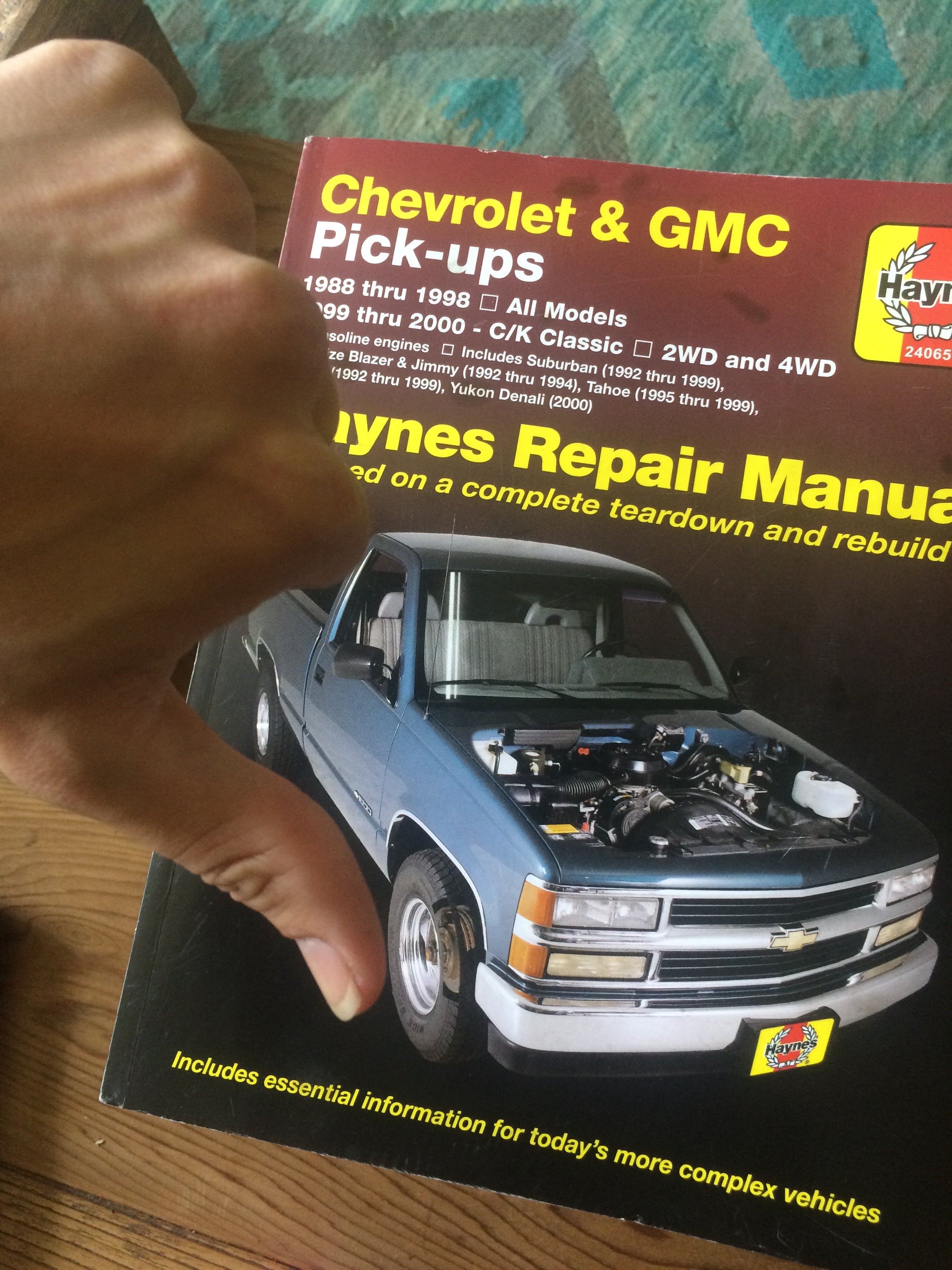 "Future Heap Owner" (aperiodic)
"Future Heap Owner" (aperiodic)
08/22/2018 at 15:27 • Filed to: Sweet sweet antifreeze
 1
1
 32
32
 "Future Heap Owner" (aperiodic)
"Future Heap Owner" (aperiodic)
08/22/2018 at 15:27 • Filed to: Sweet sweet antifreeze |  1 1
|  32 32 |
I should have listened when The Actual Rootwyrm advised me to throw the Haynes manual in the trash.

I’ve concluded that my knock sensor is fried because I cannot get any resistance reading between it and ground. So last night I picked up a deep 7/8” socket and a replacement. I double-checked my Haynes manual for removal procedure, and it’s pretty much “remove the distributor if it’s up top, then remove the sensor.”
So I go crawl under the truck since mine is below my exhaust manifold, and get to removing the stubbornly wedged- in sensor without a breaker bar (because my only one is 3/8” drive and the socket is 1/2”). After a few minutes of whacking the wrench handle alternated with pulling as hard as I can, it begins to turn.
I’m feeling very pleased with myself because I was worried I would not be able to get it off, but that feeling turns as soon as I pull the sensor out and I’m rewarded with ... coolant flooding out of the hole!
After 15 seconds I manage to get the sensor back in, but now my glove, arm, and shirt are thoroughly soaked with coolant. I take my shirt off and use that and some rags to mop it all up the best I can, spray the rest down with water — as we said at the nuclear reactor I worked at, “dilution is the solution to pollution” — then go clean myself up.
After I’m no longer covered in ethylene glycol, I do some searching on the internet and discover that, yes, coolant coming out of this hole is expected, so you should either drain the engine or be prepared. Thanks for nothing, Haynes Manual. I’m now seriously considering forking over the dough for the factory service manual.
 CarsofFortLangley - Oppo Forever
> Future Heap Owner
CarsofFortLangley - Oppo Forever
> Future Heap Owner
08/22/2018 at 15:31 |
|
I find my Haynes manual quite useful, if only as a reference guide on the D100
 LOREM IPSUM
> Future Heap Owner
LOREM IPSUM
> Future Heap Owner
08/22/2018 at 15:31 |
|
Step 1: Disassemble engine
Step 2: R epair failed component
Step 3: Reassemble engine
That’ll be $9.95 please.
 Die-Trying
> Future Heap Owner
Die-Trying
> Future Heap Owner
08/22/2018 at 15:36 |
|

 RamblinRover Luxury-Yacht
> Future Heap Owner
RamblinRover Luxury-Yacht
> Future Heap Owner
08/22/2018 at 15:43 |
|
Haynes is an excellent manual.

 Highlander-Datsuns are Forever
> Future Heap Owner
Highlander-Datsuns are Forever
> Future Heap Owner
08/22/2018 at 15:46 |
|
I find it particularly useless
, yet I keep it and still try to understand what the fuck I’m supposed to do. 9 times out of 10 I would be better off not referencing
it at all.
 CalzoneGolem
> Die-Trying
CalzoneGolem
> Die-Trying
08/22/2018 at 15:54 |
|
What is this
A F arside for ants?
 HammerheadFistpunch
> Future Heap Owner
HammerheadFistpunch
> Future Heap Owner
08/22/2018 at 15:56 |
|
Haynes manuals are nearly good for nothing.
 random001
> HammerheadFistpunch
random001
> HammerheadFistpunch
08/22/2018 at 16:03 |
|
Not true! I once had to start a fire, and all I had was a Haynes manual for starter fuel. Worked amazing! I mean, it was covered in grease, oil, and gas, and I’m sure that helped, but yeah...for starting fires.
 RallyWrench
> Future Heap Owner
RallyWrench
> Future Heap Owner
08/22/2018 at 16:04 |
|
I’ve never heard of a knock sensor in a coolant passage, is that a GM thing?
 Die-Trying
> CalzoneGolem
Die-Trying
> CalzoneGolem
08/22/2018 at 16:07 |
|

THERE we go....... good heads up........
 Spamfeller Loves Nazi Clicks
> HammerheadFistpunch
Spamfeller Loves Nazi Clicks
> HammerheadFistpunch
08/22/2018 at 16:10 |
|
They work excellent for:
- Throwing at the parts manager when he argues back
- Throwing at the service manager when he argues back
- Pranking the mechanic you hate
-
Doorstops
- Kindling
 Spamfeller Loves Nazi Clicks
> Future Heap Owner
Spamfeller Loves Nazi Clicks
> Future Heap Owner
08/22/2018 at 16:13 |
|
But it’s based on a “ complete teardown and rebuild” !*
* - Ran when parked. No lowballers. They know what they have.
 Future next gen S2000 owner
> HammerheadFistpunch
Future next gen S2000 owner
> HammerheadFistpunch
08/22/2018 at 16:17 |
|
They are useful as a place to set your cold beverage of choice.
 My bird IS the word
> Future Heap Owner
My bird IS the word
> Future Heap Owner
08/22/2018 at 16:19 |
|
Fyi- my 1978 gm factory service manual isn't much better.
 Future Heap Owner
> LOREM IPSUM
Future Heap Owner
> LOREM IPSUM
08/22/2018 at 16:20 |
|
Too real
 LOREM IPSUM
> Future Heap Owner
LOREM IPSUM
> Future Heap Owner
08/22/2018 at 16:22 |
|
Allow me to give you a close up diagram as well , with absolutely no point of reference as to where it might be located on the vehicle.
That's helpful too, isn't it?
 Future Heap Owner
> RallyWrench
Future Heap Owner
> RallyWrench
08/22/2018 at 16:22 |
|
... I guess? Until I found other people talking online about coolant spilling out during knock sensor replacement, I was half-convinced my engine was seriously messed up.
 Future Heap Owner
> My bird IS the word
Future Heap Owner
> My bird IS the word
08/22/2018 at 16:22 |
|
... great
 Future Heap Owner
> Highlander-Datsuns are Forever
Future Heap Owner
> Highlander-Datsuns are Forever
08/22/2018 at 16:24 |
|
Haha, I’m starting to have similar thoughts. I keep looking at it, not finding much useful , and then looking at YouTube videos and thinking “why don’t I just look for a video first?”
 Future Heap Owner
> CarsofFortLangley - Oppo Forever
Future Heap Owner
> CarsofFortLangley - Oppo Forever
08/22/2018 at 16:28 |
|
Most of my problems stem from this manual being very vague and/or wrong about the differences between all the engines, fuel delivery technologies, minor model year changes, and major generation changes it claims to cover. If the D100 is more consistent, it probably does a lot better job. My manual for my ninth-generation Corolla, which covers only one generation with one minor revision, has been much more accurate.
 Highlander-Datsuns are Forever
> Future Heap Owner
Highlander-Datsuns are Forever
> Future Heap Owner
08/22/2018 at 16:30 |
|
I used Youtube for my last few repairs and they were considerably easier. That being said youtube videos are edited for time so its
really deceiving
how long it might take to perform a task.
 Future Heap Owner
> Spamfeller Loves Nazi Clicks
Future Heap Owner
> Spamfeller Loves Nazi Clicks
08/22/2018 at 16:30 |
|
I dunno, it seems too soft to inflict much pain or discomfort when it connects with the parts or service manager.
 CarsofFortLangley - Oppo Forever
> Future Heap Owner
CarsofFortLangley - Oppo Forever
> Future Heap Owner
08/22/2018 at 16:30 |
|
The d100 (and the slant 6) were pretty standard for many years.
 Future Heap Owner
> LOREM IPSUM
Future Heap Owner
> LOREM IPSUM
08/22/2018 at 16:35 |
|
I am getting flashbacks
 Spamfeller Loves Nazi Clicks
> Future Heap Owner
Spamfeller Loves Nazi Clicks
> Future Heap Owner
08/22/2018 at 16:45 |
|
Yes, but if I actually injure them, that increases the chance they will fuck it up from 95% to 100%.
 I like cars: Jim Spanfeller is one ugly motherfucker
> HammerheadFistpunch
I like cars: Jim Spanfeller is one ugly motherfucker
> HammerheadFistpunch
08/22/2018 at 17:02 |
|
Emergency toilet paper
 I like cars: Jim Spanfeller is one ugly motherfucker
> Future Heap Owner
I like cars: Jim Spanfeller is one ugly motherfucker
> Future Heap Owner
08/22/2018 at 17:03 |
|
Here’s a Hayne’s guide to every repair:
1. Buy the Bentley
2. Find the procedure in the Bentley
3. Throw away the Hayne’s
 If only EssExTee could be so grossly incandescent
> Future Heap Owner
If only EssExTee could be so grossly incandescent
> Future Heap Owner
08/22/2018 at 17:06 |
|
I’m scared to see what an FSM for my car looks like

 If only EssExTee could be so grossly incandescent
> HammerheadFistpunch
If only EssExTee could be so grossly incandescent
> HammerheadFistpunch
08/22/2018 at 17:07 |
|
Is chilton any better?
 If only EssExTee could be so grossly incandescent
> Highlander-Datsuns are Forever
If only EssExTee could be so grossly incandescent
> Highlander-Datsuns are Forever
08/22/2018 at 17:09 |
|
I can’t do YouTube videos because it’s frustrating to have to seek through 24 minutes of some guy yapping on and on to find the 20 second section that actually shows you what you need.
 Future Heap Owner
> If only EssExTee could be so grossly incandescent
Future Heap Owner
> If only EssExTee could be so grossly incandescent
08/22/2018 at 17:58 |
|
These days they are the same company, so I would be surprised if the content were any different. I dunno when exactly Haynes bought Chilton, though, so maybe if you go back far enough they get better.
 Urambo Tauro
> Future Heap Owner
Urambo Tauro
> Future Heap Owner
08/22/2018 at 22:26 |
|